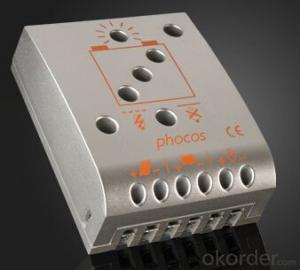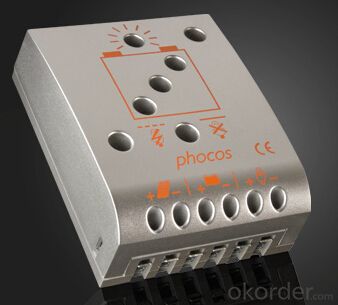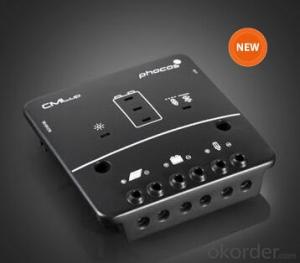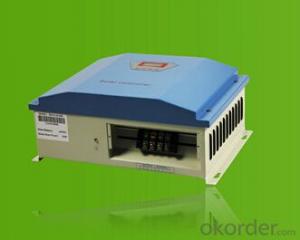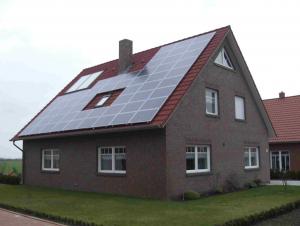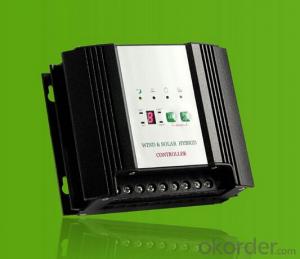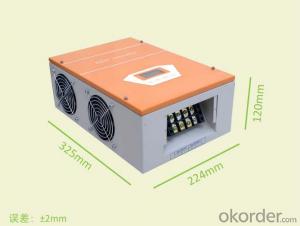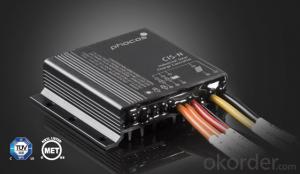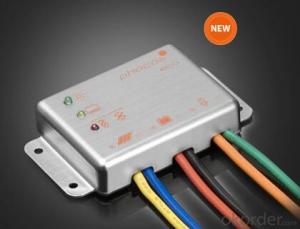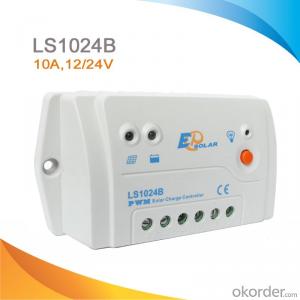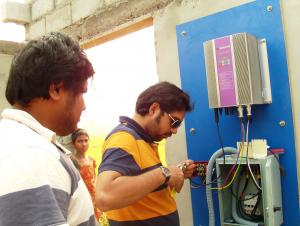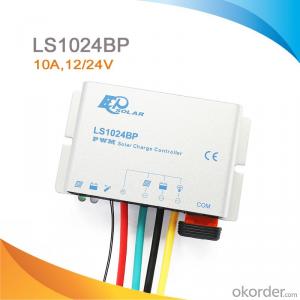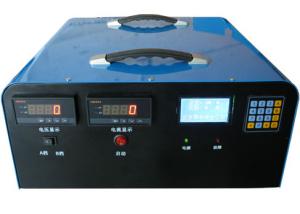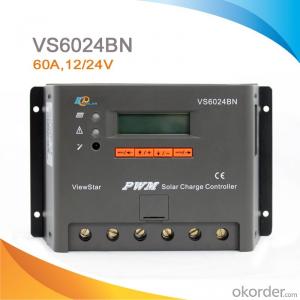CML Series (5-20A) MPPT Solar Charge Controllers
- Loading Port:
- China Main Port
- Payment Terms:
- TT OR LC
- Min Order Qty:
- -
- Supply Capability:
- 10000 unit/month
OKorder Service Pledge
OKorder Financial Service
You Might Also Like
· Battery State-of-Charge display with 3 LEDs
· Acoustic load disconnect pre-warning
· PWM-regulation (series type)
· Boost, equalize and float charging, also for VRLA
· Automatic 12/24 V detection
· Integrated temperature compensation
· Large terminals (up to 16 mm2wire size)
· SOC and voltage controlled LVD
· Fully electronically protected
· The CML series is a sophisticated solar charge controller family for low cost applications. The electronic circuit is equipped with a microcontroller that provides high- efficiency charging technology together with a number of outstanding status display, warning and safety functions. The temperature-compensated three-stage PWM charging method (boost-equalization-float) is now adjustable tosealed and vented lead-acid batteries. The new version also allows an either SOC or voltage controlled low voltage disconnect function. The battery status is clearly indicated by three LEDs.
· As the first controller on the market in this price range it comes with an acoustic low voltage load disconnect pre- warning feature.
- Q: How do PWM solar controllers differ from MPPT solar controllers?
- PWM (Pulse Width Modulation) solar controllers and MPPT (Maximum Power Point Tracking) solar controllers differ in their methods of regulating and optimizing the charging and output of solar panels. PWM solar controllers work by rapidly switching the connected solar panels between the battery bank and charge/discharge cycles. They regulate the charge rate by adjusting the width of the pulses, effectively controlling the voltage output. However, PWM controllers do not actively track the maximum power point of the solar panels, resulting in lower efficiency and reduced energy harvest, especially in cold or cloudy conditions. On the other hand, MPPT solar controllers utilize advanced algorithms to actively track and adjust the operating point of the solar panels to maximize power output. By continuously adjusting the voltage and current, MPPT controllers match the output of the solar panels to the battery bank's charging requirements more efficiently. This enables MPPT controllers to extract more power from the solar panels, especially in low light or non-optimal temperature conditions. Consequently, MPPT controllers are generally more efficient and effective at utilizing the available solar energy.
- Q: Can a solar controller be used with solar panel theft prevention systems?
- Yes, a solar controller can be used with solar panel theft prevention systems. A solar controller is a device that regulates the voltage and current generated by solar panels and ensures that the energy is efficiently utilized or stored in batteries. While solar panel theft prevention systems primarily focus on securing solar panels against theft, a solar controller can be integrated into these systems to enhance their functionality. By connecting the solar controller to the solar panel system, it can monitor the power output and provide real-time information on the energy generation. This can be useful in detecting any unusual drop in power production, which could indicate tampering or theft of the solar panels. Additionally, a solar controller can also be programmed to send alerts or notifications in case of any unauthorized access or tampering, further enhancing the security of the solar panel system. Therefore, incorporating a solar controller into a solar panel theft prevention system can provide an added layer of protection and help ensure the safety and efficient operation of the solar panels.
- Q: How does a solar controller prevent overloading of the solar panel system?
- A solar controller, also known as a charge controller, plays a crucial role in preventing overloading of the solar panel system. Its primary function is to regulate the charging process and ensure that the energy generated by the solar panels is properly utilized without causing damage to the system. One of the main ways a solar controller prevents overloading is by monitoring the voltage and current levels of the solar panels. It constantly measures the input from the panels and compares it with the system's capacity. If the input exceeds the system's maximum capacity, the controller takes action to prevent overload. To prevent overloading, the solar controller employs various techniques. One common method is called pulse width modulation (PWM). PWM controllers regulate the flow of energy by rapidly switching the input current on and off. By controlling the duration of each pulse, the controller ensures that the energy delivered to the system matches the demand, preventing overload. Another technique used by solar controllers is called maximum power point tracking (MPPT). MPPT controllers optimize the efficiency of the solar panel system by finding the point at which the panels produce the maximum power output. By continuously adjusting the input voltage and current, the controller ensures the system operates at its peak performance, thus preventing overloading. Additionally, solar controllers often include safety features such as short-circuit protection and overload protection. These features detect and respond to abnormal situations, such as a sudden surge in voltage or excessive current, by shutting down the system temporarily or redirecting the excess energy to prevent damage to the panels or other components. In summary, a solar controller prevents overloading of the solar panel system by monitoring the voltage and current levels, employing techniques like PWM and MPPT to regulate the energy flow, and incorporating safety features to protect the system from abnormal situations. Its role is crucial in maintaining the efficiency and longevity of the solar power system.
- Q: What is the role of a solar controller in preventing battery over-discharge?
- The role of a solar controller in preventing battery over-discharge is to monitor the energy levels of the battery and regulate the charging and discharging process. It ensures that the battery is not drained beyond a certain threshold, which helps to prolong its lifespan and prevent irreversible damage. The solar controller acts as a safeguard by disconnecting the load from the battery when it reaches a low voltage, preventing over-discharge and maintaining the battery's overall health.
- Q: What is the cost of a solar controller?
- The cost of a solar controller can vary depending on several factors such as brand, capacity, features, and quality. On average, a basic solar controller can range from $20 to $50, while more advanced models with additional functionalities can cost anywhere from $50 to $200 or more.
- Q: Can a solar controller be used with solar-powered surveillance systems?
- Yes, a solar controller can be used with solar-powered surveillance systems. A solar controller helps regulate the power flow from the solar panels to the surveillance system, ensuring optimal charging and preventing overcharging of the batteries. This helps maintain the system's efficiency and prolongs battery life, making it an essential component for solar-powered surveillance setups.
- Q: How the solar controller wiring,
- Power cord - usually with the controller with a three-pin plug power cord, has a good controller; sensor line - two lines and four lines, according to the label with a plug or terminal connected to the controller; solenoid valve - Two, according to the label connected to the controller; electric auxiliary heating line - three, according to the label connected to the heating bar.
- Q: How do I determine the maximum load output current for a solar controller?
- To determine the maximum load output current for a solar controller, you will need to consider a few key factors. Firstly, check the specifications provided by the manufacturer of the solar controller. This information is usually available in the product manual or on the manufacturer's website. Look for the maximum load output current rating, which is typically given in amps (A). Additionally, consider the size and capacity of your solar panel system. The maximum load output current of the solar controller should be compatible with the capacity of your solar panels. If your solar panels have a higher output current than the controller's maximum load output current, it may lead to system inefficiencies or potential damage. Moreover, it is important to consider the load you intend to connect to the solar controller. Determine the maximum current that the load requires to operate properly. Ensure that the load's current requirement is within the range supported by the solar controller. If the load's current requirement exceeds the maximum load output current of the controller, it may result in the overload or malfunctioning of the controller. Lastly, always consult with a professional or an electrician experienced in solar systems if you have any doubts or concerns. They can provide valuable advice based on your specific system requirements and help ensure that the solar controller is properly matched with the load and solar panel capacity.
- Q: How does a solar controller protect against reverse current flow?
- A solar controller protects against reverse current flow by utilizing diodes that prevent the flow of current in the opposite direction, ensuring that energy generated by the solar panels is not wasted or lost.
- Q: Can a solar controller be used with solar panel cleaning drones?
- Yes, a solar controller can be used with solar panel cleaning drones. The solar controller is responsible for regulating the power flow from the solar panels to the drone's batteries, ensuring optimal charging and preventing overcharging. By using a solar controller, the cleaning drones can effectively utilize solar energy to power their operations while maintaining the health of their batteries.
Send your message to us
CML Series (5-20A) MPPT Solar Charge Controllers
- Loading Port:
- China Main Port
- Payment Terms:
- TT OR LC
- Min Order Qty:
- -
- Supply Capability:
- 10000 unit/month
OKorder Service Pledge
OKorder Financial Service
Similar products
Hot products
Hot Searches
Related keywords
